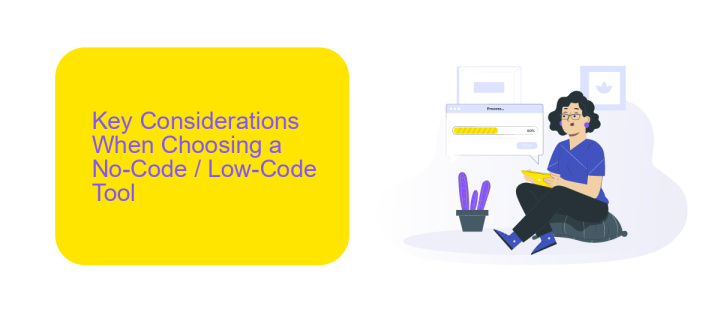Which No-Code / Low-Code Tool to Choose
Choosing the right no-code or low-code tool can be a game-changer for businesses and individuals looking to create applications without extensive programming knowledge. With a plethora of options available, it's crucial to understand the strengths and weaknesses of each platform to make an informed decision. This article explores top tools, helping you find the best fit for your needs.
Introduction
In today's fast-paced digital world, businesses and individuals are increasingly turning to no-code and low-code tools to streamline their workflows and accelerate development processes. These platforms empower users to create applications, automate tasks, and integrate services without the need for extensive coding knowledge.
- Ease of use: Intuitive interfaces make it accessible for non-developers.
- Cost-effective: Reduces the need for hiring specialized developers.
- Speed: Rapid development and deployment of applications.
- Flexibility: Wide range of functionalities to cater to different needs.
One such tool, ApiX-Drive, stands out by offering seamless integrations with various services, enabling users to automate workflows efficiently. Whether you need to connect your CRM with marketing platforms or synchronize data between different applications, ApiX-Drive simplifies the process, saving you time and resources. Choosing the right no-code or low-code tool can significantly impact your productivity and success, making it essential to evaluate your options carefully.
Key Considerations When Choosing a No-Code / Low-Code Tool

When selecting a no-code or low-code tool, the first consideration should be the specific needs of your project. Assess whether the tool supports the functionalities you require and can scale as your project grows. Additionally, evaluate the user interface and ease of use, especially if team members have varying levels of technical expertise. A user-friendly platform can significantly reduce the learning curve and increase productivity.
Another crucial factor is integration capabilities. Ensure the tool can seamlessly connect with your existing systems and third-party applications. Services like ApiX-Drive can be invaluable in this regard, offering robust integration solutions that simplify the process of connecting various applications. Lastly, consider the level of customer support and community resources available. A tool with active user forums, comprehensive documentation, and responsive customer service can be a game-changer when troubleshooting issues or seeking advice on best practices.
Top No-Code / Low-Code Tool Vendors

Choosing the right no-code or low-code tool can significantly impact your project's success. With numerous vendors available, it's essential to understand what each offers to make an informed decision.
- Bubble: Known for its robust capabilities, Bubble allows users to design, develop, and host applications without writing code.
- OutSystems: This platform combines no-code and low-code features, making it suitable for both beginners and experienced developers.
- ApiX-Drive: A powerful tool for setting up integrations without coding, ApiX-Drive simplifies connecting various services and automating workflows.
- Appgyver: Ideal for building mobile and web apps, Appgyver offers a visual development environment with extensive customization options.
- Zapier: Known for its automation capabilities, Zapier helps users connect different apps and automate repetitive tasks easily.
Each of these tools offers unique features tailored to different needs. Whether you need a comprehensive development platform like Bubble or a specialized integration tool like ApiX-Drive, there's a no-code or low-code solution to fit your requirements. Evaluate your project's specific needs to choose the best vendor.
Choosing the Right Tool for Your Business

Choosing the right no-code or low-code tool for your business can be a daunting task given the myriad of options available. The key is to identify your specific needs and evaluate how each tool aligns with these requirements. Start by assessing the complexity of the tasks you need to automate and the level of customization required.
Consider the scalability of the tool, especially if you anticipate growth. A tool that works well for a small team may not suffice as your business expands. Additionally, examine the integration capabilities of each tool. For instance, ApiX-Drive offers seamless integration with various platforms, making it easier to automate workflows and synchronize data across different applications.
- Identify your business needs and goals.
- Evaluate the scalability of the tool.
- Check integration capabilities, such as those offered by ApiX-Drive.
- Consider the ease of use and learning curve.
- Review user feedback and case studies.
Ultimately, the best no-code or low-code tool for your business will depend on a combination of these factors. Take the time to trial a few options and see which one aligns best with your operational needs and long-term objectives. Making an informed decision will save you time and resources in the long run.


Conclusion
Choosing the right no-code or low-code tool depends on your specific needs, project complexity, and technical expertise. While platforms like Bubble and Adalo are excellent for building web and mobile applications, tools like Airtable and Notion offer robust database management and collaboration features. Each tool has its strengths and limitations, so it's essential to evaluate them against your project requirements.
For those needing seamless integrations between different services, ApiX-Drive offers a powerful solution. It allows you to connect various applications without any coding, automating workflows and saving time. Ultimately, the best no-code or low-code tool is the one that aligns with your goals, budget, and technical capacity, enabling you to bring your ideas to life efficiently and effectively.
FAQ
What is the difference between no-code and low-code tools?
Can I integrate my existing software with a no-code or low-code tool?
How secure are no-code and low-code applications?
What kind of support can I expect from no-code and low-code tool providers?
Can I automate workflows and set up integrations with a no-code tool?
Time is the most valuable resource in today's business realities. By eliminating the routine from work processes, you will get more opportunities to implement the most daring plans and ideas. Choose – you can continue to waste time, money and nerves on inefficient solutions, or you can use ApiX-Drive, automating work processes and achieving results with minimal investment of money, effort and human resources.

